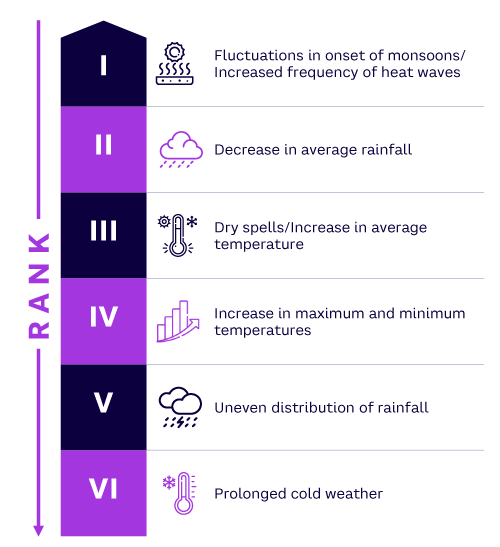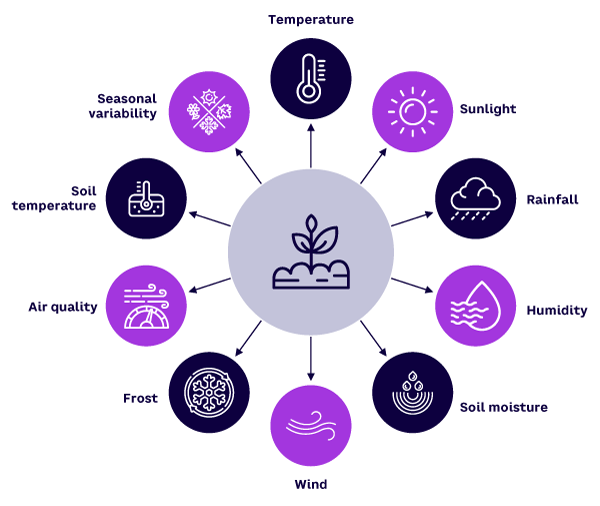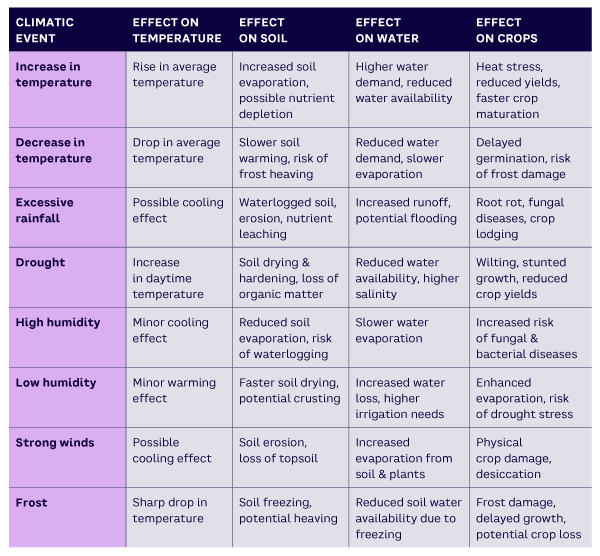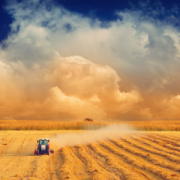AMPLIFY VOL. 37, NO. 7

The adverse impacts of climate change affect both developed and developing countries, but developing countries and poor smallholder farmers are more vulnerable as they sorely lack adequate adaptive capacity. Smallholder farmers’ high dependence on rain-fed agriculture makes them especially susceptible to the profound impacts of climate change. This is compounded by elevated levels of poverty, inadequate infrastructure, and lagging technological development. Consequently, climate change is set to adversely affect many agricultural-dependent communities in developing countries, aggravating food insecurity and global poverty.1
The adverse impacts of climate change on agriculture include rainfall, temperature, heat waves, weed modifications, pests and microbes, global changes in atmospheric carbon dioxide, ozone levels, and sea level fluctuations.2 Climate change has destructive effects on plant growth and crop production. Weather variations collectively have positive and negative outcomes, but the negative effects are more pronounced. Extreme weather disasters, such as drought and flooding, have an outsized impact on vulnerable populations.3
The agriculture sector has the potential to contribute to climate change mitigation and increasing resilience through adaptation.4 Farmers’ adaptive capacity involves their ability to apply new strategies and solutions to address the adverse effects of global warming on food production.5 The ability to adapt is especially vital for smallholder farmers in developing countries.
Adaptation requires planning, investment, and formulation of relevant policies to enhance farmers’ resilience to climate change. Our recent study focused on how climate change is causing severe problems for farmers in Haryana, India. In this article, we review farmers’ perceptions of climate change and provide sample adaptation measures being adopted to enhance resilience. Such insights are vital to guide policy formulation.
Response to Climate Change by Haryana Farmers
Since agriculture is affected by climate change in several ways, farmers can provide first-hand observations of climate change impacts and adaptation options. Our study looked at the impact of climate change in two of Haryana’s agroclimatic zones: southwestern and northeastern.
Haryana is frequently referred to as “India’s food mine.” Approximately 80% of the state’s population is directly or indirectly engaged in agriculture. In addition to producing enough grain for its own needs, Haryana contributes significantly to the nation’s grain supply, including a vast amount of basmati rice. The state produces a large amount of winter crops, including rice, wheat, bajra (pearl millet), and maize. Its autumn crops include sugarcane, groundnuts, maize, and paddy. The state’s northwestern region is ideal for growing rice, wheat, vegetables, and temperate fruits, while the southwest is best suited for producing premium agricultural products (e.g., tropical fruits, exotic vegetables, and herbal and medicinal plants).
Farmers’ Awareness of Climate Change
Our study involved 240 farmers in the Fatehabad and Hisar districts. Figure 1 shows that Haryana farmers are well aware of climate change effects and illustrates a precise ranking. Most farmers in the study said they are seeing more frequent heat waves and greater fluctuation in the onset of monsoons. A decrease in average rainfall, an increase in average temperature and dry spells, an increase in maximum and minimum temperatures, and an uneven distribution of rainfall also ranked high in awareness. The lowest area of awareness is around prolonged cold weather.

The study data suggests that the current climate pattern is characterized by increasing temperature extremes, variability in precipitation, and significant impacts from fluctuations in monsoon onset and heat waves.
Nearly 90% of respondents reported they face huge losses because of water accumulation after heavy rainfalls. More than half (58%) cited drought, storm, weeds, crop disease, and pest outbreaks as current common causes of agricultural losses. Seventy-three percent said erratic rainfall had caused major losses in agricultural productivity in the last five years. The majority (93%) said environmental pollution (from pesticides, chemical fertilizers, and waste materials) is a common cause of agricultural loss. Fifty-five percent suggested that climate change has adversely affected soil fertility, crop rotation, and water shortages.
Climate Change Effects & Adaptations
Over the past few decades, Haryana has seen a significant shift toward growing paddy, sugarcane, and wheat, driven by unpredictable climatic conditions, market demand, government policies, and the relatively high profitability of these crops.6
As stated, most farmers attribute crop failure to water accumulation following heavy rainfall and extreme weather events like heat waves. Erratic rainfall disrupts planting and harvesting schedules, affecting crop yields. Extreme weather conditions, such as droughts, floods, and heat waves, pose significant risks to crop health and farmer productivity. Temperature fluctuations, particularly high temperatures and heat waves during critical growth periods, can lead to crop stress and failure.7 These climatic events greatly disturb the critical natural conditions required for crop cultivation (see Figure 2).

Micro-Level Changes & Macro-Level Challenges
The changing climate has led to a rise in macro-level challenges. Soil degradation and water scarcity are two such issues, primarily caused by wind, water erosion, and grazing. Water erosion is caused by heavy rainfall that causes runoff, carrying away soil particles and depleting soil nutrients, leading to reduced soil fertility. Additionally, overextraction of groundwater has become a critical issue, with more than half of groundwater withdrawals exceeding recharge each year. This leads to the continuous depletion of groundwater resources. Paddy cultivation, which is highly water-intensive, exacerbates this problem by lowering water tables. Traditional irrigation methods, such as flood irrigation, further contribute to water scarcity by wasting a significant amount of water.8
Table 1 shows how various climatic events affect temperature, soil, water, and crops. An increase in temperature leads to higher evaporation and nutrient depletion in soil, along with increased water demand and heat stress in crops, resulting in reduced yields and faster maturation.
Conversely, a decrease in temperature slows soil warming, reduces water demand, and can delay crop germination, with a risk of frost damage. Excessive rainfall can cool temperatures but often results in waterlogged soil, erosion, and increased runoff, causing root rot and fungal diseases.
Droughts raise daytime temperatures, dry out soil, and reduce water availability, leading to wilting, stunted growth, and lower yields. High humidity slightly cools the air but can cause waterlogging and increases the risk of fungal and bacterial diseases. Low humidity accelerates soil drying and water loss, raising irrigation needs and risk of drought stress. Strong winds may cool the air but they erode soil and increase evaporation, leading to physical crop damage. Frost can reduce water availability and cause significant crop damage, delaying growth and perhaps crop loss.

Case Study: Cotton Crop Cultivation in Haryana
Haryana farmers, particularly those involved in cotton cultivation, are increasingly affected by climate change. The region has experienced a significant rise in temperature, leading to an increase in pest attacks on cotton crops, reducing yields and threatening the viability of this traditional crop. The rise in temperature has exacerbated water scarcity, further diminishing yields by delaying plant flowering.
Faced with these challenges, many farmers have reconsidered their crop choices and are choosing paddy cultivation. Paddy is perceived as more resilient to the changing climate and is supported by government price guarantees. (The government promises to buy any harvest that farmers cannot sell as much or more than the market price.) This provides a guaranteed income, making it an attractive option for farmers looking to optimize their revenue in uncertain times.
However, the shift to paddy cultivation has brought its own set of problems. One of the most significant issues is the practice of residue burning, which has severe environmental consequences, including soil fertility degradation. Residue burning after harvesting is common, due to the time and money involved with removing the residue from the previous crop before the start of the next season. Crop-residue burning leads to a decline in soil fertility, directly impacting future crop yields. Over time, this soil-health reduction threatens farmers’ long-term earning potential, trapping them in a cycle of reduced productivity and income.
This scenario highlights the complex challenges that Haryana farmers face due to climate change. The shift to paddy cultivation offers a temporary solution to the immediate impacts of climate change but introduces new problems that could undermine the long-term sustainability of agriculture in the region. Addressing these issues requires a comprehensive approach that considers not only immediate economic benefits, but also the long-term environmental and social implications of farming practices in a changing climate.
Mitigation Efforts & Adaptive Strategies
Farming methods that support soil health are essential for making agriculture more sustainable while improving food-growing conditions. In northwest India, efforts to eliminate the practice of burning crop residue have shown promise. This practice destroys soil nutrients, contributes to air pollution, and emits greenhouse gases that exacerbate global warming.9
Smallholder farmers, who often lack the knowledge and resources to cope with climate change, are beginning to use adaptive strategies like altering planting dates and developing climate-resilient crops. Unpredictable and erratic rainfall can trigger drought conditions, leading to crop failures. Conservation agriculture, which involves principles like minimal soil disturbance, crop rotation, and permanent soil cover, has been identified as a pathway to sustainable agriculture. In particular, zero tillage, which leads to higher yields with less variability in crops like wheat, is being promoted. No-till practices have been highlighted as an alternative to conventional tillage, which is crucial for mitigating the impact of climate change through carbon sequestration.10-13
Despite these efforts, there are serious barriers to effective climate change mitigation in India. Resource constraints, such as high production costs, high interest rates, volatile market prices, and rising costs of fossil fuel–based inputs, have trapped many farmers in a vicious cycle of debt. Farmers also face challenges related to water shortages, including a lack of hydrological information, a large gap between water demand and supply, water pollution, and the overexploitation of groundwater. Moreover, many farmers lack the technical knowledge to adopt emerging technologies that could help them mitigate the effects of climate change. Economic challenges like low income levels, lack of access to credit, and market volatility further exacerbate the situation, pushing many farmers into debt and financial instability. Inefficient institutions, complex land ownership, and tenure systems also hinder progress.14-17
Conclusion & Recommendations
This article has highlighted the significant risk posed by climate change to agriculture. In the developing country of India, farmers are aware of these risks and are implementing adaptation strategies. Unfortunately, the long-term effect of some of the adaptation strategies can worsen the situation.
We also explored how micro-level climate events over time can create macro-level challenges that significantly affect agriculture productivity. Without concerted efforts, food security and the incomes of millions of smallholder farmers will be at risk.
Government support for crop insurance and sustainable farming practices can help buffer smallholder farmers from the effects of climate change. Support for drought-resistant crops and improvements in irrigation infrastructure could help farmers manage risks associated with increasingly erratic weather patterns.
Table 2 shows four areas that should be part of any climate adaptation and mitigation framework. Farmer involvement in developing and implementing climate change adaptation strategies is crucial to enhancing agricultural productivity and ensuring the sector’s sustainability,18 and new policies are necessary to control the pollution emitted by agricultural activities.19

Much more is needed to help farmers develop and implement effective adaptation and mitigation strategies, and this will require public funding. Humanity’s greatest challenge is feeding the world’s human population in a sustainable, nutritious, equitable, and ethical way during a period of increasing climate change. Urgent transformation is vital to allow farmers to earn a living while increasing climate resilience and reducing emissions.
Acknowledgment
We would like to thank Kasuni Vidanagamachchi for providing valuable suggestions and feedback that helped improved this article.
References
1 Adimassu, Zenebe, and Aad Kessler. “Factors Affecting Farmers’ Coping and Adaptation Strategies to Perceived Trends of Declining Rainfall and Crop Productivity in the Central Rift Valley of Ethiopia.” Environmental Systems Research, March 2016.
2 Raza, Ali, et al. “Impact of Climate Change on Crops Adaptation and Strategies to Tackle Its Outcome: A Review.” Plants (Basel), Vol. 8, No. 2, February 2019.
3 Bryant, Christopher R., et al. “Adaptation in Canadian Agriculture to Climatic Variability and Change.” Climatic Change, Vol. 45, July 2014.
4 Gikunda, Raphael, David Lawver, and Juma Magogo. “Culture as a Predictor of Effective Adoption of Climate-Smart Agriculture in Mbeere North, Kenya.” Advancements in Agricultural Development, Vol. 3, No. 2, May 2022.
5 Mabe, Franklin Nantui, Daniel Bruce Sarpong, and Yaw Osei-Asare. “Adaptive Capacities of Farmers to Climate Change Adaptation Strategies and Their Effects on Rice Production in the Northern Region of Ghana.” Russian Journal of Agricultural and Socio-Economic Sciences, Vol. 11, No. 11, October 2012.
6 Kumar, Surender. “Assessment of Impacts of Climate Change on Trend and Pattern of Wheat Crop in Haryana: A Geographic Analysis.” International Journal of Basic and Applied Research, Vol. 8, No. 2, February 2018.
7 Wakweya, Rusha Begna. “Challenges and Prospects of Adopting Climate-Smart Agricultural Practices and Technologies: Implications for Food Security.” Journal of Agriculture and Food Research, Vol. 14, December 2023.
8 Deen, Sahab, and Sanju Bala. “Changing Cropping Pattern in Haryana: A Spatio-Temporal Analysis of Major Food Crops.” International Journal of All Research Education and Scientific Methods (IJARESM), Vol. 9, No. 3, March 2021.
9 Thakur, J.K., et al. “Crop Residue Burning: Consequences on Soil Microbes.” Harit Dhara, Vol. 2, No. 2, July–December 2019.
10 Altieri, Miguel A., and Clara I. Nicholls. “The Adaptation and Mitigation Potential of Traditional Agriculture in a Changing Climate.” Climatic Change, Vol. 140, September 2013.
11 Baul, Tarit Kumar, and Morag McDonald. “Integration of Indigenous Knowledge in Addressing Climate Change.” Indian Journal of Traditional Knowledge (IJTK), Vol. 14, 2015.
12 Powlson, David S., et al. “Limited Potential of No-Till Agriculture for Climate Change Mitigation.” Nature Climate Change, Vol. 4, July 2014.
13 Kumari, Mamta, and Jagdeep Singh. “Water Conservation: Strategies and Solutions.” International Journal of Advanced Research and Review, Vol. 1, No. 4, 2016.
14 Sarma, G.V. Prasada. “Campaign to Reduce Use of Chemical Fertilizers, Pesticides.” The Hindu, 28 May 2016.
15 Yadav, Reeta Devi, and Rita Goel. “Problems of Cotton Farmers in Haryana.” International Journal of Current Microbiology and Applied Sciences, Vol. 8, No. 3, 2019.
16 Hussain, Siraj, and Kriti Khurana. “Minimum Price Support, Maximum Gain for Farmers.” Deccan Herald, 9 March 2024.
17 Chintapalli, Prashant, and Christopher S. Tang. “The Impact of Crop Minimum Support Prices on Crop Production and Farmer Welfare.” UCLA Anderson Review, March 2021.
18 “Sustainable Agriculture Practices in the State.” National Bank for Agriculture and Rural Development (NABARD), accessed July 2024.
19 Sharma, Sonali. “India’s Climate Change Policy: Challenges and Recommendations.” Indian School of Public Policy, 16 January 2023.





